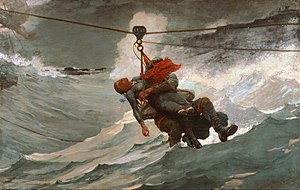
Henry Trengrouse was a British inventor who invented the "Rocket" lifesaving apparatus.

Captain George William Manby FRS was an English author and inventor. He designed an apparatus for saving life from shipwrecks and also the "Pelican Gun", the first modern form of fire extinguisher.

The Virginia Beach Surf & Rescue Museum honors and preserves the history of Virginia's maritime heritage, coastal communities, the United States Lifesaving Service, and the United States Coast Guard along the Atlantic coast.
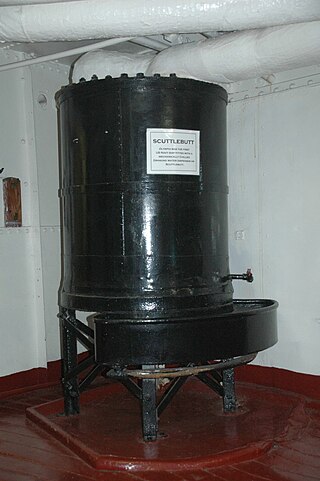
Scuttlebutt in slang usage means rumor or gossip, deriving from the nautical term for the cask used to serve water.

A Volunteer Life Brigade is a search and rescue organisation which assists HM Coastguard in the United Kingdom in coastal emergencies. Around 40 VLBs were established in the mid-to-late 19th century; today just three remain, continuing to provide shore-based search and rescue support from locations on the coast of north-east England. They are akin to, but predate, the volunteer Coastguard Rescue Service and the National Coastwatch Institution.

A Lyle gun was a line thrower powered by a short-barrelled cannon. It was invented by Captain David A. Lyle, US Army, a graduate of West Point and the Massachusetts Institute of Technology, and was used from the late 19th century to 1952, when it was replaced by rockets for throwing lines.

The Manby mortar or Manby apparatus was a maritime lifesaving device originated at the start of the 19th-Century, comprising a mortar capable of throwing a line to a foundering ship within reach of shore, such that heavier hawsers could then be pulled into place and used either to direct a rescue-boat to the ship, or, later, to mount a Breeches buoy.

Henry "Shrimp" Thomas Davies BEM was a lifeboatman from Cromer on the north coast of Norfolk, England. His uncle, Henry Blogg, gave him the nickname "Shrimp" after seeing him as a tiny baby. In 1931 he joined the crew of the Cromer lifeboat H F Bailey and became coxswain in 1947, taking over from Henry Blogg. Davies retired in February 1976, after serving as coxswain of lifeboats Henry Blogg and Ruby and Arthur Reed, having been one of Cromer Lifeboat Station's longest serving coxswains.
Irex was a sailing vessel wrecked at Scratchell's Bay on the Isle of Wight by The Needles on 25 January 1890, while on her maiden voyage.

Dunbar Lifeboat Station is a lifeboat station located in Dunbar Harbour at Dunbar, on the south-east coast of Scotland, operated by the Royal National Lifeboat Institution. The station operates a Trent-class all-weather lifeboat and a D-class (IB1) inshore lifeboat. Dunbar is one of the earlier British ports to be served by a lifeboat, the first station being constructed in 1808.

SS Monte Nevoso was a cargo steamship that was launched in 1920 in England, owned in Italy, and wrecked in 1932 in the North Sea off the coast of Norfolk.
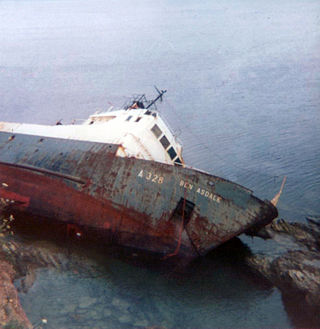
Ben Asdale was a Scottish trawler that was wrecked in December 1978 near Falmouth, Cornwall.

A bosun's chair is a device used to suspend a person from a rope to perform work aloft. Originally just a short plank or swath of heavy canvas, many modern bosun's chairs incorporate safety devices similar to those found in rock climbing harnesses such as safety clips and additional lines.

RNLB Foresters Centenary is a retired Liverpool-class lifeboat of the Royal National Lifeboat Institution (RNLI), stationed in the English coastal town of Sheringham in the county of Norfolk in the United Kingdom. The lifeboat was on station for 25 years between 1936 and 1961 when she was sold. She has been restored to her original condition and is exhibited in Sheringham Museum.
The Directorate General of Coastal Safety has been established by the Turkish Republic Council Of Ministers’ decision on 12 May 1997 as a General Directorate and State owned Organization. The mission of the foundation is to assist and improve the safety of navigation in Turkish Waters. The organization’s core competences are:

SS (RMS) Mona's Isle (III), No. 76304, the third ship in the company's history to be so named, was a paddle steamer which served with the Isle of Man Steam Packet Company until she was purchased by The Admiralty in 1915.
A line thrower is a device that casts a line to a remote position. It is used in rescues as well as marine operations. A line thrower may employ a variety of launching methods including guns, rockets, and pneumatics.
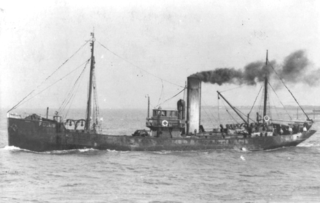
ST Pasages was originally a Canadian "Castle" – TR series minesweeping trawler built by the Dominion Shipbuilding Company, Toronto, in 1917 for service with the Royal Canadian Navy during World War I as TR 14. Following the war the vessel was taken to the United Kingdom and converted to a fishing trawler in the 1920s. Renamed Pasages, the vessel ran aground in 1931 on the Isle of Man. The vessel was wrecked and her remains can still be seen.
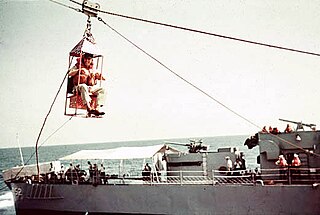
A jackstay is a cable or bar between two points to support and guide a load between those points, or as an anchor to attach something to be constrained along that line. The term is mostly used in a marine context and originated on sailing ships. Note the use of "stay" implies load bearing working rigging. In diving it is also a line to guide the movements of a diver between the endpoints.

Seascale Lifeboat Station is a former Royal National Lifeboat Institution (RNLI) lifeboat station, located in the village of Seascale, Cumberland, Cumbria.

